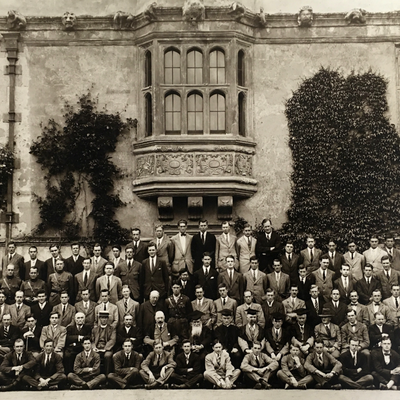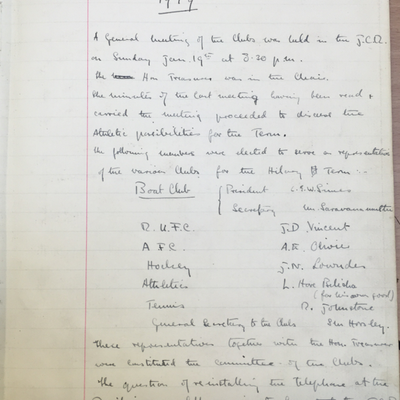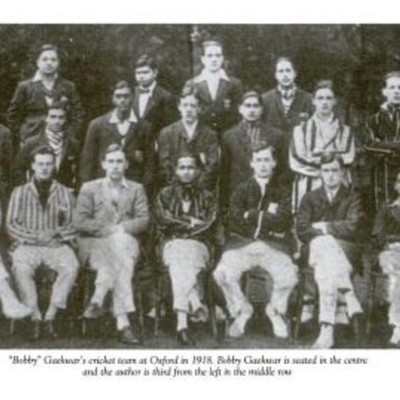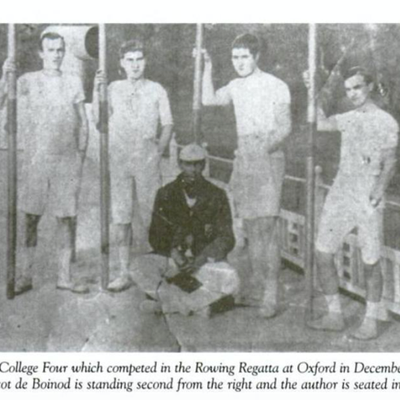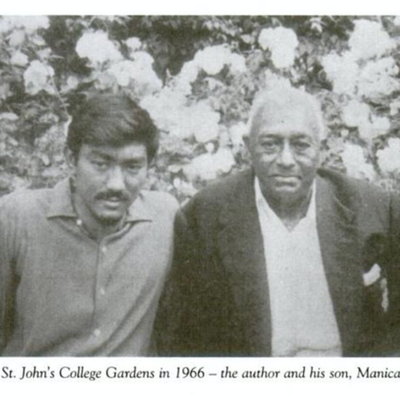Manicasothy Saravanamuttu, 1895- 1970, (SJC: 1917-19)
His father and eldest brother were both prominent medical doctors in the country, and later the same brother was Mayor of Colombo. Sara matriculated at St. John’s in 1917, and was Secretary of the Boat Club in 1919. He was a first-class sportsman, a keen cricketer, and a member of the crew that was known as the “St. John’s Four”. Photographs of the scratch transnational Cricket team (there being no varsity team in this period) known as “Bobby Gaekwar’s XI’ in which Saravanamuttu played, and of the “St. John’s Four”, appear in Saravanamuttu’s autobiography, The Sara Saga (c.1970). This is a fascinating documentation of a historically and culturally formative (and destructive) period for peninsular Malaya, a record of Saravanamuttu’s own part in that history as a journalist and editor of the Straits Echo which helped cement a cosmopolitan and multicultural identity for Penang and Malaysia, and a glimpse into student life at St. John’s and Oxford during and just after World War I. Saravanamuttu gives us vivid thumbnail sketches friends and notable figures at his college and the university in his time, especially as the war ended and a number of students returned from the front. Amongst others, he mentions Leslie Hore-Belisha, later Minister for Transport, who was Saravanamuttu’s contemporary at St. John’s. Hore-Belisha was elected President of the Unions in 1918 after Saravanamuttu introduced him to the Oxford Majlis (the Oxford Indian Society) and Indian students, who formed a good proportion of total votes, gave Belisha their bloc-vote helping him win the election. In return, Hore-Belisha gave an Indian Debate at the Oxford Union in 1919, where it was proposed “That India should be given Independence” - the motion was won by one vote.[i] Saravanamuttu also mentions a famous St. John’s vs. Trinity cricket match he played in, in which the Trinity wicket was kept by Edward Gent, later Governor of the Malayan Union.[ii]
Unfortunately, Saravanamuttu was unable to complete his undergraduate course at St. John’s and left without taking a degree. The cause of this is given in his autobiography, where he describes being caught by the Proctor staggering down the High Street with a friend, one night in the Summer of 1919, having celebrated “lavishly” after being elected a member of the “Authentics” (an Oxford University cricket team). They were both sent back to their College, however - while Saravanamuttu’s friend was merely sent down or “rusticated” for a term - Saravanamuttu, being a Colonial Student, was reported to the Director of Colonial Students to whom it was recommended that he should be “sent to a University nearer to home”. Saravanamuttu writes that he received a letter signed by Winston Churchill as Secretary of State for the Colonies, informing him that a passage had already been booked for him on a ship back to Malaya. Saravanamuttu chose not to do this out of “shame” at being sent home so ignominiously, and instead remained in London for some time. He seems to have borne no rancour for this singular treatment meted out to him because he was a Colonial instead of a Home Student; perhaps it was understood by colonial students as the way things were at the time and accepted without resentment.[iii] Saravanamuttu mentions the St. John’s gardens and its bursar, H. J. Bidder, with affection, and the final photograph in the chapter on St. John’s and Oxford in his book is of Saravanamuttu with his son Manicam on a visit to the College in 1966.
On his return from Oxford, Saravanamuttu worked for a newspaper in Ceylon, and then became editor of the Straits Echo in Penang. By the 1930s, according to historian Su Lin Lewis, the Echo was one of the most popular newspapers in North Malaya, its circulation having expanded threefold under the editorship of Saravanamuttu. Lewis describes Saravanamuttu as an Oxford-educated Fabian, and the first non-white Chief Editor of a Malayan newspaper, under whom many post-Independence Malaya’s leading journalists trained; a result of the left-leaning Echo’s editorial stance was that its keenest readers became the vanguard of a cosmopolitan ideal of Malaya.[iv]
In 1942 when the Japanese
occupied Burma and Malaysia, Cosmopolitan Penang was abandoned by its western
population and “witnessed the hypocrisies of British imperial paternalism” as
the British rapidly pulled out leaving Penang open to the Japanese.
Saravanamuttu, who was interned by the Japanese, is credited with having
“raised the white flag” over Fort Cornwallis and led the organisation of
food, fuel and essential services, for the population.[v] After the war,
Saravanamuttu served as a diplomat, representing Ceylon in Singapore,
Malaya and Indonesia, and was on the Organising Committee of the first
Asian-African Conference at Bandung, Indonesia, which laid the foundations for
the Non-Aligned Movement. We hope to do more work on Saravanamuttu as there are
few primary sources available on him, apart from his own autobiography, however
Saravanamuttu’s role as a key figure in the modern history of print
and journalism, the shaping of the twentieth century intellectual and
cosmopolitan worlds of South and South East Asia, and the political,
cultural and economic formation of Penang and its influence on modern nations
in the region.[vi]
[i] Manicasothy Saravanamuttu, The Sara Saga (c. 1970; Penang: Areca Reprints, 2010), p. 20
[iv] Su Lin Lewis “Print and Colonial Port Cultures of the Indian Ocean Littoral: Penang and Rangoon”, Journal of the Malaysian Branch of the Royal Asiatic Society , December 2009, Vol. 82, No. 2 (297), Peranakan Chinese in Penang and the Region] (December 2009), pp. 9-24, 20-21.
[vi] Also see Michael J. Montesano, “Review of Cities in Motion: Urban Life and Cosmopolitanism in Southeast Asia, 1920-1940 by Su Lin Lewis”, Sojourn: Journal of Social Issues in Southeast Asia , July 2017, Vol. 32, No. 2 (July 2017), pp. 440-451 Stable URL: https://www.jstor.org/stable/44668431
